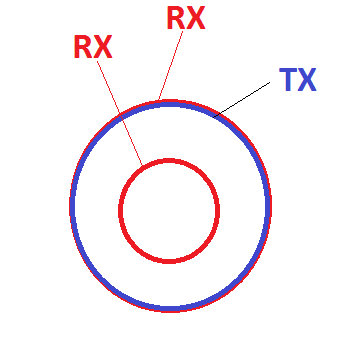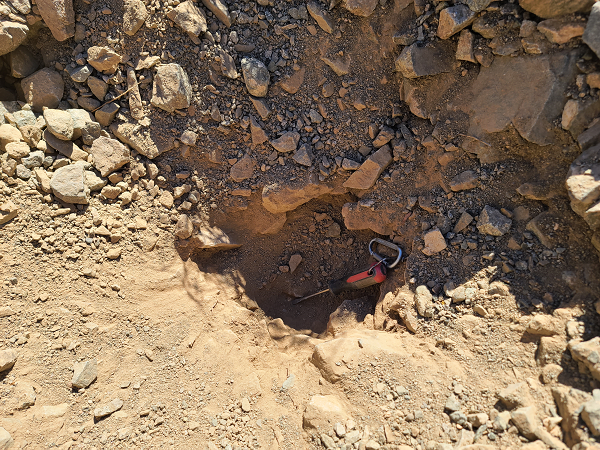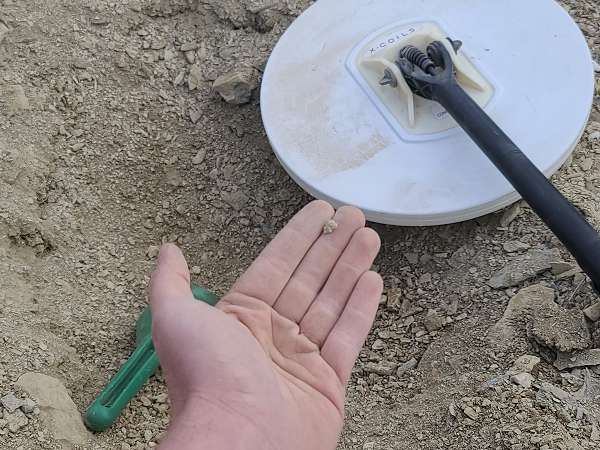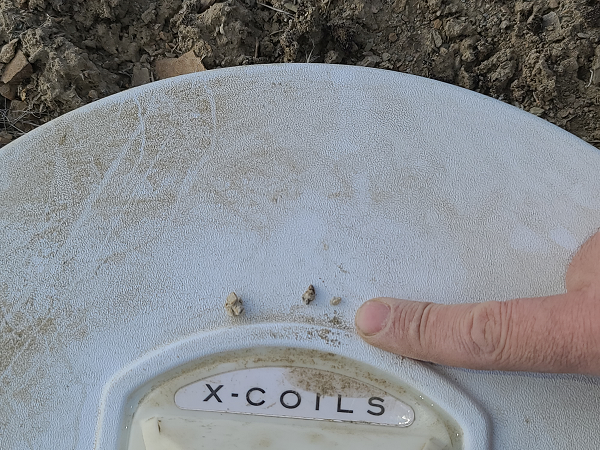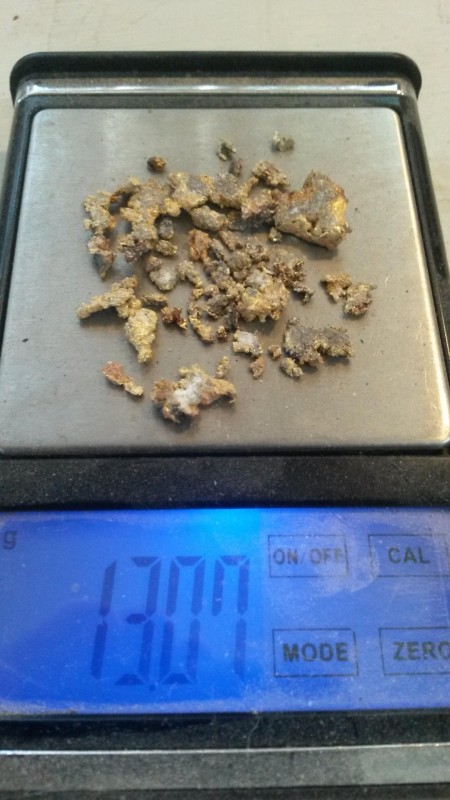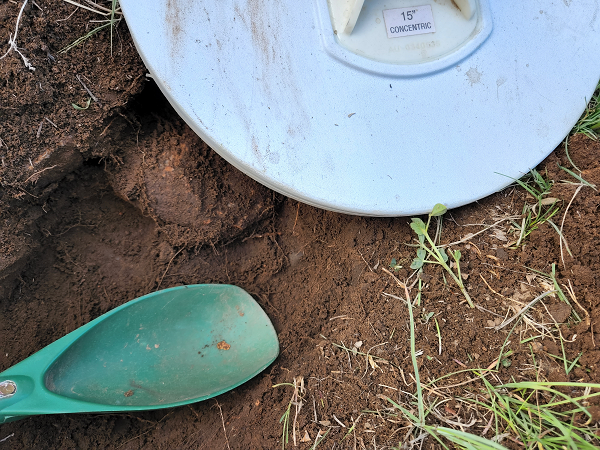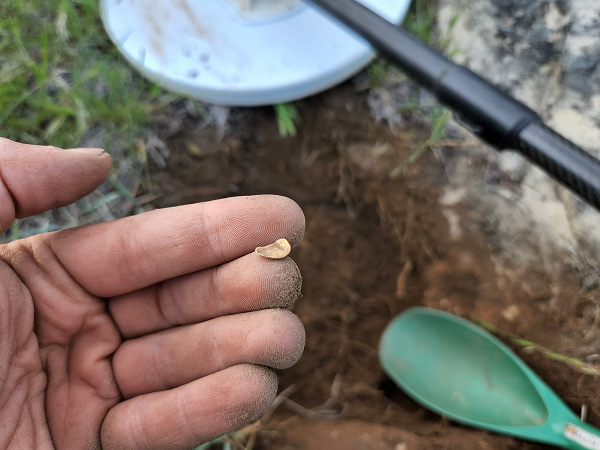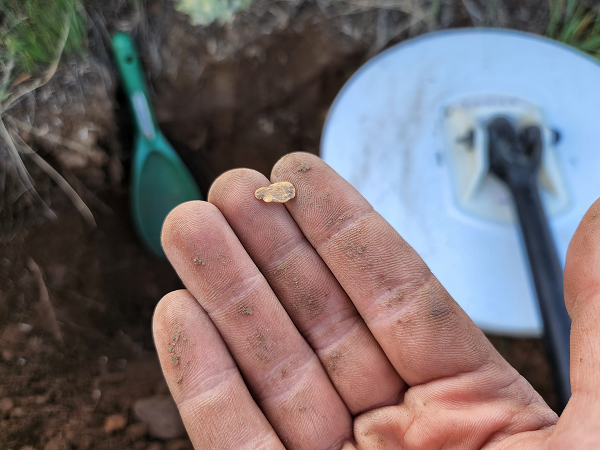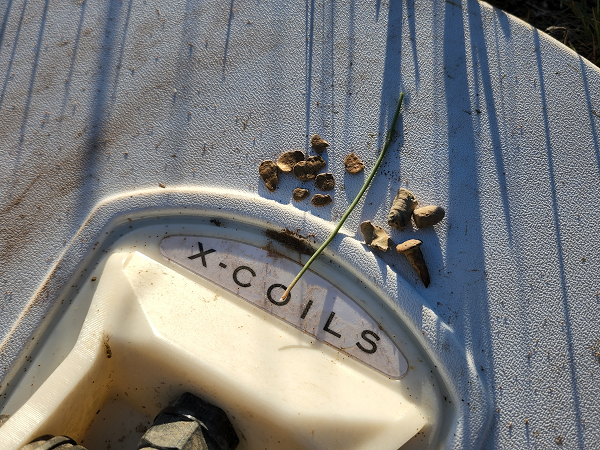-
Posts
2,464 -
Joined
-
Last visited
Content Type
Forums
Detector Prospector Home
Detector Database
Downloads
Everything posted by jasong
-

Who Has Had Issues With Their Gpx 6000?
jasong replied to Goldseeker5000's topic in Detector Prospector Forum
The early 4500's all required main board replacements too though don't forget. Mine was one of them. It was my first expensive detector purchase. -

Running The 15" Cc X Coil Over A 6000 Patch
jasong replied to jasong's topic in Minelab Metal Detectors
Thanks, kinda what I was wondering but unsure about without asking. That leads to what you probably already guessed my follow up question is then: With the GPZ, would there be some even further performance gains to be had by stacking both 1 TX and 1 RX flat winding of the full coil diameter on the outside. Then 1 smaller inner RX winding inside those? Idea being the TX saturates the entire ground under the coil, and thus the larger RX can still detect large deep nuggets just like a mono, but the smaller inner RX also allows added sensitivity and depth to the smaller, less deep nuggets. Best of both worlds? Or no free lunches? Guessing the two RX windings need to be separated from the TX by some specific distance for capacitive or inductive coupling reasons, rather than stacked? Edit: diagram for clarity -
Same, kept hearing the rattling and thought I broke a piece of plastic off inside. Then eventually the box just separated from the shaft and I had to tape it together to finish the day out, and then asked if I would void my warranty by opening it up when I got to my RV. No worries, popped it open and did exactly what you did and put it back together with threadlocker. It actually happened when a buddy was filming a video on one of my claims, so I guess that particular issue is going on Youtube at some point, but it's not really a detector specific channel. Wasn't really a big deal though, but still, yeah one of those things like "this is a $6000 product? seriously?". Which was I think was more or less my immediate reaction when it happened mid swing on video and having to tape my new detector together. My friend's 11" coil from that same trip went bad and was replaced under warranty too. But so far mine is still doing ok, if a little more touch sensitive then it was new.
-

Running The 15" Cc X Coil Over A 6000 Patch
jasong replied to jasong's topic in Minelab Metal Detectors
Well GR guy, it's a day of coincidences haha because I just happened to be finishing typing up the post below right when you posted, this might answer your question a bit? Not to change subjects, but for what it's worth I decided to go dig my test patch up earlier today. It's out behind a mountain near town and the entire area is being turned into a weekend shooting range and getting absolutely covered with piles of ammunition debris and other trash now, creeping closer and closer to my test patch every year, so it's not much use to me anymore after they shoot it up. I made this patch when I got my first 12" and 17" spiral X Coils, so I could compare targets. I dug holes with each nugget until the stock coil just barely no longer made a signal, then buried them. The ground is almost totally inert with very little salt and iron component. The nuggets (by memory) are 1/4 gram, 3/4 gram, 1.5 gram, 3 gram, and 7 gram. Not sure of their exact depth, just that whatever depth they are at is where the stock 14x13 coil stopped hearing them. The 12 and 17" spirals both heard all the nuggets, no problem. But that's not surprise. Anyways, I knew I wasn't going to hit the bigger ones with the 6000, but I was pretty sure I'd get at least the 1/4 grammer to some extent, it wasn't really very deep. Not a peep from a single nugget though from the 6000. So I think the GPZ even with the stock coil is outperforming the 6000 over almost all classes of nuggets. Other than maybe 0.1 gram and under or something. This here is another recent reason why I just really think the 6000 needs a bit better performance, it's good, but not quite good enough to be an only detector. But if a good coil can boost it's performance at least a bit without digging into weight, it would sure give me a lot more confidence in the machine when I'm exploring, as it definitely seems to be missing some fairly shallow stuff that I would have otherwise assumed it was tagging with ease. -

Running The 15" Cc X Coil Over A 6000 Patch
jasong replied to jasong's topic in Minelab Metal Detectors
A big positive of the 6000 is it's light weight and balance, so I don't see a huge market for anything bigger than an 18" on it anyways, or you'd just use the GPZ instead if things are already getting heavy and inconvenient. I'm actually pretty happy with the 11" mono other than depth related issues. I don't really need to find anything smaller than the 0.03g stuff I'm already finding. The weight is fine to swing all day. What I think the 6000 needs is a bit more depth out of a coil that isn't much heavier, on the 1/2+ gram stuff, to make it a more well rounded machine in general. Something like a 12" concentric, if such a coil would go appreciably deeper than the 11" mono on the slightly bigger stuff while simultaneously not being much heavier than the 11" (of course we have extra winding weight) then it seems like the 6000 becomes a much more capable detector for general use. I'm looking at it in terms of a main coil replacement, a new primary coil. Or, conversely, if a smaller concentric like a 8-9" could get as much depth as the 11" mono but be lighter weight to swing, then that might have a market too as a main coil replacement for those who want added maneuverability without losing depth from stock. I think big coils would probably max out around 16" or 18" for usability on the 6000 in specific. But it might be good to have one in that range too, for situations that require them. Depending on weight, it'd probably still be better than using the GPZ, even if it wasn't outright as deep. The main problem I see with the 6000 (aside from EMI and the speaker) that needs addressed is that it definitely does leave a lot more stuff than I would like in the ground. It's close, but not quite good enough to be an "only" detector for many people. If it was just a bit better then I might even be tempted to sell my GPZ because my elbow is not getting any better. -

Running The 15" Cc X Coil Over A 6000 Patch
jasong replied to jasong's topic in Minelab Metal Detectors
Ok, now you are confusing me again. I asked in the other thread before I posted this thread if there might be any performance gains with concentrics on the 6000. And your response was something like "haven't people noticed what coils X Coils did and didn't decide to actually make for the 6000"? None of which included concentrics. The inferrence I took from that being they already looked into concentrics for the 6000 and decided they weren't worth making. I can't remember the exact verbiage, but seemed to me that was the gist of things. But now it seems like you are saying they think they might look into them? I'm lost. -

Running The 15" Cc X Coil Over A 6000 Patch
jasong replied to jasong's topic in Minelab Metal Detectors
The key, I think, would be finding an existing CC that is more or less the same size as one of the existing 6000 mono coils, so performance could be directly compared. We already know larger coils go deeper on PI's, the question we need answered is wether a concentric goes deeper than the same size mono of current 6000 design (we aren't sure yet if it's better or worse in some ways than older GPX monos), and on which sizes of gold if so. How it deals with ground and EMI comparitively speaking to a similar size mono would also be of great interest. (edit: or thinking about it more logically, you could also just compare one of the old 11" mono Commanders to to the 11" 6000 mono, both on the 6000, to create a baseline comparison between old monos and whatever performance changes these newer 6000 monos might have too). Were there ever any CC's made for GPX's that were around the same size as the 11" and 17" elliptical on the 6000 by any chance? Would be cool if someone had one sitting in their closet they wanted to sell. Also I'm curious: with a PI there will only be 2 windings on a concentric instead of 3 like with the GPZ. What are the reasons/advantages of putting the TX on the outside vs the RX on the outside? I think I might try to wind one of my own coils this fall after I get my house fixed and sold and a bit more time on my hands for prospecting. I have an old 4500 I can start with to test it so I don't make a mistake with a more expensive machine. -

Running The 15" Cc X Coil Over A 6000 Patch
jasong replied to jasong's topic in Minelab Metal Detectors
Seems in physics, everything has a give and take. Sort of the nature of thermodynamics and no free lunches. Make gains here, and you lose some gains over there, etc. If I understand what you are saying here, I think you are right. The CC will "give" up a bit of raw depth to big stuff vs monos, but the smaller RX on the CC might "take" some sensitivity/depth to the smaller stuff relative to a mono. Maybe start getting some performance close to or even outdoing the 8" on the GPZ? All this stuff really has me thinking seriously about learning to make my own coils so I can just answer my own questions and stop wondering. -

Running The 15" Cc X Coil Over A 6000 Patch
jasong replied to jasong's topic in Minelab Metal Detectors
Hate to say it but even though they are great on a GPZ, sounds like CC's just won't offer as much performance gain on PI's using monos already as they do on the GPZ when compared with using the DOD. Talking to/reading Simon (who I assume is getting some info from X Coils guys), Chet, and others I think I have a rough idea why this is the case, but I make no assertions as to the accuracy of my rough understanding. A PI using a mono has both a large RX and TX loop already (same loop), it's kinda maximized depth for a given size coil already. Sounds like the CC's have advantage over the DOD's because the windings are different sizes and in the case of a CC, one of the lobes (I can't even remember which is which now, TX or RX) is larger than it would be on a DOD, which is one reason why depth is increased. And some more stuff having to do with winding coupling, distances, etc that are a bit beyond my understanding. But compared to detectors already running monos that by nature already have both RX and TX loops maximized for a given size (since they are the same loop), the CC's are going to have either the RX or TX lobe (again I forget which) be smaller, so performance gains may not be as large. That doesn't mean there might not still be room for some clever coil design on 6000 coils though. Obvious one being if the aftermarket coils are not (apparantly?) using flat windings. Which, after all the talk, we still have no clear answer on and are left guessing (and will surely get our wrists slapped for venturing such guesses). Good sentiment and I'm sure you'll rake the likes in since no one out there disagrees. But you might want to tone down the calling us "bitchers" and telling us our opinions are like an ass (presume yours are golden though?) if you want a better reception from people. No one attacked you, no one even mentioned your name. No need to come in hot and look for a fight. Just because we don't have an inside line to Bruce Candy or Minelab engineers doesn't mean we aren't allowed to talk about things we find interesting. And yes - that means guessing at some things that involve information we'd love to learn, but simply are not priivy too. Doesn't mean the topic is off limits to discuss. -

Running The 15" Cc X Coil Over A 6000 Patch
jasong replied to jasong's topic in Minelab Metal Detectors
Dug one last one out of my old phone. This was a 3.5 grammer that I think was around 18"-20" deep after I stood back and compared the hole to the diameter of the coil. I was positive it was going to be a 1/2oz or even 1 oz'er after I got below about 15" or 16" deep. I was pretty surprised when it was just a little 3 grammer. I didn't think it was even possible to hit something that small, that deep. I thought for sure it was going to be a nice big lump that I didn't want to damage, so I stopped hacking a wide hole with my pick, got on my stomach, and started digging a smaller hole within the hole using my screwdriver and pinpointer. I'm a 6ft tall guy and this one was near the extent of what I could keep digging with my arm while on my stomach. Once the pointer got a signal near the bottom of the smaller hole I was making, I moved layer by layer away until I saw the glint of gold since I wanted to know exactly where the nugget was, and not risk digging past it and having it fall back in the hole and making me think it was deeper than it was. What you see is exactly where it was when I detected it on surface. This was with the 17" CC X Coil and was the first day I tried it out. This is a tiny spot that has been heavily worked by 2 GPZ's plus me on the 17" Spiral, and there were no signals at all left, not even a whisper. This nugget was a quiet, but easily noticable signal for me with the 17" CC though. I also got a 3/4g at 10" or so, and a 1.5g at what I seriously think was something like 14-15". Not the greatest vid, but again it was just mostly for personal record and wasn't planning on posting. I also can't show the horizon where the detector sits because this one is close enough to recognizable features that I don't want to lose yet another testing spot to the ticks and leeches that like hunting my spots down. The nugget is at the tip of the screwdriver in this photo here for those who don't want to watch the short vid. That is a full size Harbor Freight flathead screwdriver for size reference - the hole was a crater to get down that deep. There are definitely spots in Arizona that deep gold is still lurking... -

Running The 15" Cc X Coil Over A 6000 Patch
jasong replied to jasong's topic in Minelab Metal Detectors
I was just literally writing something to the effect of "I'm curious what Chet thinks about making some 6000 concentrics and if performance increases are possible or not worth pursuing on the 6, right as you posted that. 😁 -

Running The 15" Cc X Coil Over A 6000 Patch
jasong replied to jasong's topic in Minelab Metal Detectors
-

Running The 15" Cc X Coil Over A 6000 Patch
jasong replied to jasong's topic in Minelab Metal Detectors
What does aftermarket coil selection have to do with counterfeiting? Again, coils aren't counterfeit detectors, no one is mimicing anything. Aftermarket coils are detector accessories, and they've been available for almost every model since I started detecting and X Coils designs and builds their own to sell, not copies. Unless you have some kind of inside track knowledge that no one else knows about? No one is asking Minelab to open up their internal hardware for copying en masse. In your example, it'd be like Apple forcing ONLY Apple branded or approved products to be connected via USB, bluetooth, etc (headphones, chargers, external devices like computers, etc). Minelab is doing exactly this by saying no one can connect anything to their own detector they paid for, unless it's approved by the company. Worse, they are failing to offer approved versions of the things their customers have clearly been asking for for years, so there are no real options for people who paid $10k for a top-tier piece of equipment that historically has always had options. -

And To Think, I Complain About Digging Pellets
jasong replied to phrunt's topic in Detector Prospector Forum
This kind of stuff is so sad. We hear about blood diamonds, but there are similar conditions mining other stuff too going largely unreported, at least in the US. The jadeite mining in Myanmar is another one. Literally entire meth addicted families, children, trying to stay up and scavenge the dozer pushes for as many hours as possible. And there have been a lot of large scale mine collapses killing these children and families, the last one killed 200 people and it never even made the news here in the US. There are something like 1+ million children trapped in child labor in mining and other industries there. https://www.bbc.com/news/world-asia-53568497 -

Running The 15" Cc X Coil Over A 6000 Patch
jasong replied to jasong's topic in Minelab Metal Detectors
Agree. The GPZ clearly has a lot of capability able to be unleashed just by some clever coil design. I can't imagine Minelab, the people who actually designed the detector, didn't understand this early on too. The lack of coils seemed pretty intentional. Given how ergonomically unsound the 7000 was due to excessive weight, and the potential damage that occur to people's arms, if there was an intentional preventing of the release of lighter, smaller coils that could have relieved potential damage to people's arms earlier, then I find that decision to be particularly tone deaf and disrespectful to loyal customers. I've spent something close to $30k on Minelab products. Yet companies who might get something closer to $3k over the same period from customers seem to care much more about the people who buy their products. -

Running The 15" Cc X Coil Over A 6000 Patch
jasong replied to jasong's topic in Minelab Metal Detectors
I am able to browse my broken phone as a hard drive on my computer now. Still can't find my AZ concentric stuff, not sure why it isn't stored in DCIM as it should be. Anyways, I totally forgot that I gave the concentrics a very brief run in NNV though, and found a few pics, they aren't the greatest photos taken right at sundown and hard to see the dirt encrusted gold, so I never posted them originally. But here they are anyways since I'm digging through old stuff and on the subject of concentrics. It was a short trip as I was there for other purposes, but I stopped for an hour at a heavily detected patch on the way back to my hotel, this patch is so depleted that I don't even detect here anymore except to test new equipment since the ground is basically lacking any real targets anymore with existing equipment. Heavy salt, and heavily detected by every detector since the first SD. I had to work glacially slow through the salt groan, but still got one. This one was a grammer or something, don't remember exactly at this point. I'm posting this stuff going off rough memory at this point. It definitely suffered in the salt, but not really any more or less than I'd expect any larger coil would. Targets were still recognizable in the salt groan, just as with the stock coil. I also ran the 8" out here another trip, and it did great in the salt, better than the 6000 w/11" in my opinion. Tried another similar well flogged patch which I'm sure a number of forum members are familiar with, about an hour here. Got 3 nuggets. One of them had a nice cube on the tip of it (left most nugget). The middle one came from below a pocket I found in 2015 or so with the GPZ, the pocket was filled with black sooty carbon/graphite, and you can sorta see the carbon on this nugget even though this photo isn't the greatest. Someone has since discovered my old pocket and raked a large area beneath it down, and took a bunch of the dirt home with them. It's really crystalline gold when it's all cleaned up. This stuff all got tossed into CLR and sold a few days later to fund gas back home so I don't have any pics of it cleaned up unfortunately. It was all crystalline though. The tiny 3rd nugget was the smallest I'd ever found with a large coil and was something under 0.10 grams but I can't recall weight exactly now. So, about 3 grams from very well flogged patches in about 2 hours of actual detecting. Not bad for places I've given up on years ago. If a person has enough old patches with proven production and depth, it's probably possible to pay a concentric off quick. I've only used mine lightly and I think I'm close to or over 1 oz with them now from just worked, dead patches. However, I think the major value of these coils is for people who have known, proven ground to work. Here is some of the gold from the original pocket, after I got smashy with the quartz. This wasn't found with the concentric, it was found in 2015 or 2016 with the stock GPZ, just a reference to know what the gold actually looks like and it's character, since my pictures above don't really show it due to dirt covering. It's prickly, crystalline, hard to detect stuff normally. -

Running The 15" Cc X Coil Over A 6000 Patch
jasong replied to jasong's topic in Minelab Metal Detectors
Hey Bill, I'm in some terrain that in many ways resembles that around Rye Patch. I would say as a whole it's less salty though, or more patchworked alkali anyways, with areas of more extreme salt and less extreme salt. Also, the ground is more mineralized with regards to the ferrite component here too. But similar conditions. I think the 6000 is a great detector for NNV, and also for Colorado. If I only wanted one detector to primarily work those two places, I'd personally choose the 6000 so I think you made a good trade. In fact, when I detect down in your part of Colorado later this year, I'll probably just take the 6000 with me. The steeps...too gnarly with the GPZ unless I have some very specific, small areas to concentrate on. But yeah, these concentrics are definitely deep in the places you can run them. Heavy salt is not particularly their forte though. But they are doing good with the ferrite mineralization (no worse than the stock coil anyways, maybe slightly better), and these things just absolutely slay the deeper ground and have literally produced deeper gold every single patch I've tried them on. For places like Arizona they are amazing. For people that have a stable full of good, deep, productive old patches, these things are literally like having a GPZ 8000 to me, a tool that is clearly more capable than anything else on the market right now. I'm actually pretty surprised there aren't more AZ detectorists using one, but that's just fine with me. I hope I'm the only one in the US using them because they are a major advantage to have. I'll admit to being a bit speculative here myself and other threads. I got a bit concerned we might just see some size variation and no focus on improved performance when I saw Coiltek say something along the line that he didn't know what flat windings were. Maybe a semantic mixup, and not technical? Unsure. Lack of clarity leads to speculation though, naturally. That, plus no post about upcoming concentrics from either manufacturer. It naturally leads to a bit of speculation wether we will see some things or not that we are all discovering this last year can add some significant boost in performance to the Z, and wonder if maybe the same can apply to the 6? Add into the mix that neither Minelab nor coil manufacturers have stated if there are specific restrictions on what can and can't be made for the 6000, and people are gonna start wondering on their own if such restrictions might exist, based on history. Since we clearly saw restrictions on the 7000 limiting aftermarket coil manufacturing, even if it's unclear to this day exactly what the restrictions were, it's easy to assume restrictions are potentially in play with the 6000 too, especially since the chip still exists. -

Running The 15" Cc X Coil Over A 6000 Patch
jasong replied to jasong's topic in Minelab Metal Detectors
I'm hoping they get a lighter GPZ out sooner than later. As much as I'm loving these concentrics on the GPZ, my elbow makes me pay for swinging that machine for a week afterwards now, even with lighter coils. It's hard to stop though, knowing it almost always pulls something extra up. I had an S20 phone die in Arizona over the winter (well, screen went bad, I can't login now), had some photos of running the 17" CC in a small, deep gold area that was worked by 2 GPZ operators and me with the 17" spiral, no signals left at all when I took the 17" CC in. This post was about what the 6000 missed, but I can also show what the stock GPZ and even the 17" spiral miss compared to the 17" CC too. Going to work on recovering data and vids off this old phone today, hopefully can get them all back. -
Why not just toss JW's new coil on your 6000 in the same spot, should be able to tell pretty quickly if there is an issue. I think the real strength of the 6000 is just running it in Auto+ with no threshold and using it for prospecting/exploring for the easier targets, covering ground. Usually they are 50%+ of targets in new spots, especially where bedrock is shallow, so can be cleaned up quick with the 6000. Don't really need to listen for every tiny faint threshold warble doing that, bring the GPZ in later for that.
-

Running The 15" Cc X Coil Over A 6000 Patch
jasong replied to jasong's topic in Minelab Metal Detectors
Agree with most of that. But I really hope this isn't true. I guess I stand alone here, but I really, really dislike the Bluetooth stuff. Even this APTx low latency stuff I find to be incredibly annoying with it's delay. I'm not sure how people don't notice the delay on it, I find it so distracting. The faster you swing, the worse it gets. And when in prospecting mode moving quickly and covering ground, it's almost unusable to me. The WM12 has no discernable delay, and I would take a WM14 100x over some Chinese headphones and an Aptx wireless module. Man I hope they don't do that. -

Running The 15" Cc X Coil Over A 6000 Patch
jasong replied to jasong's topic in Minelab Metal Detectors
There is enough performance gain with these CC's on the GPZ that I'm not even joking when I say Minelab could probably just supply one of these coils with a lighter design 7000 and call it the GPZ 8000 - 40% deeper for $8000, and probably be understating things, based on what I'm seeing. It really makes me wonder what we'll see with the new GPZ whenever it comes out. The bar is high. It absolutely needs to be lighter weight, because it's pretty easy to get a much cheaper big bump in performance with the CC coils right now already. IMO, they need to bring more to the table than just depth and weight too, it needs to deal with salt and mineralization better than the 7000 too, in order to distance itself from what can be done with the buying a 15 or 17" CC on the original GPZ. That all of course assumes we even have a new GPZ in works, which itself is just a total guess based on history. -

Running The 15" Cc X Coil Over A 6000 Patch
jasong replied to jasong's topic in Minelab Metal Detectors
So due to these factors, we should probably expect a bigger performance gain from concentric coils on machines that use these DOD coils stock than we would expect to see on traditional PIs using monos which already have a large RX/TX loop? -

Running The 15" Cc X Coil Over A 6000 Patch
jasong replied to jasong's topic in Minelab Metal Detectors
These are the first concentrics I've used on any detector, so I'm just basically learning about them. I'm curious why they were never very common on the GPX/GP/SD's? A VLF has some ZVT like qualities, are they less effective with true PI detectors? -

Running The 15" Cc X Coil Over A 6000 Patch
jasong replied to jasong's topic in Minelab Metal Detectors
Got out for a bit of exploration on the ATV and 6000 again. More scatter shot prospecting, trying to expand gold bearing zones. Covered a ton of new ground. Unfortunately nothing new turned up. I also brought the skunk buster with me (GPZ + 15" concentric X Coil) so I could end the day with something in my pocket if exploration failed to produce, and decided to run the rest of the sun down by hitting some deep gold bearing ground for a few hours. The 6000 had given no gold in this deeper ground, other than a few nuggets I recovered towards the spot where bedrock started poking out of the dirt towards the periphery. Within a few minutes I hit a small one. It was about 4" deep and I could actually still see my old footprints where I had run the 6000 over this very spot. Quite a loud target on the 15" CC and another one of those targets that left me scratching my head how the 6000 missed it. I was very careful to remove layer by layer so I could know exactly where the nugget was in the hole, it ended up being at the top of the scoop almost under the rock. Keep in mind, this 15"CC X Coil is IMO outperforming the 17" spiral X Coil, which itself is outperforming the ZSearch, which itself is outperforming the stock 14x13 GPZ coil. So it's not like I'm running anything even remotely close to the stock the GPZ here, and if a reader is running stock, they shouldn't expect the same large differences I am seeing. But still, the amount of missed targets I've been finding that seem like they should have been found with the 6000 is pretty exceptional IMO. I worked closer to the edge of the bedrock, but still in the deeper dirt, with my old footprints still visible in a grid. And about 10 minutes later I hit another target, this one virtually screaming. Again I picked down layer by layer with my fingers until I saw the glint of gold so I could see exactly where the nugget was at in the hole. This one was probably 6-7" deep, in some roots. It ended up weighing something around 0.45 grams. A bit more work around the bedrock periphery and I hit on 5 more little nuggets, almost all in the grass roots. I was intentionally ignoring the salt signals (of which there were many), also rejecting any faint or somewhat questionable signals. I was concentrating only on the obvious, strong target signals, of which there seemed to be plenty. It's pretty clear to me now that the 6000 is missing a lot of stuff in this size range below about 5", something good to know so I understand when and where to use the 6000 and how to interpret my results with it. I began the walk back to my ATV, doing a quick swing over some of the ground with no bedrock exposed. I had one final strong signal, this one was down probably 9-10", at the tip of the scoop. It ended up being the heaviest of the day at a whopping 0.57 grams, a bit thicker than the others. So, 8 nuggets (on the left, low light makes the contrast bad) for the short session and 4 bits of trash. All the trash was also 4" or below, the 6000 got all the pellets here. The smallest nugget 0.12 grams and the largest was 0.57 grams. I am in an area where the gold rarely gets above 1 gram. I tried a bit of prospecting, working a little new area on the way back that I had found 1 straggler nugget with the 6000, but it was totally infeasible due to salt. Maybe easy to understand why I was earlier so concerned with determining if larger or concentric coils can be made for the 6000 to give it a little performance boost. I wasn't rabble rousing, it was a serious question that needed an answer. Seeing results like this instantly makes me wonder what a 12" lightweight concentric on the 6000 could have done as far as cutting into missed nuggets goes, while staying light weight. But, seems that is not possible for whatever reasons on the 6000. So, good to know now. And I can only hope that coil manufacturers offer concentric options in the future for detector models that are compatible with them. I'm left curious if CC's offer as much depth gain on PI's, or if they outperform on ZVT tech only, relatively speaking. -

Anyone Familiar W/ The Eureka District, Arizona?
jasong replied to BagdadAz's topic in Detector Prospector Forum
Just as a general idea, there is detectable gold in the wider Bagdad area, if that helps keep the spirits up for a little more exploration closer to home. I've had absolutely horrible and entirely regretable experience sharing specific areas with some people in Arizona, leaving a lot of areas I loved completely and utterly decimated. It's happened to others too, and there are a lot of people highly guarded about discussing areas in Arizona as a result of it. It's a shame because there are some amazing finds in the state that just never get seen at all now because of it all.


